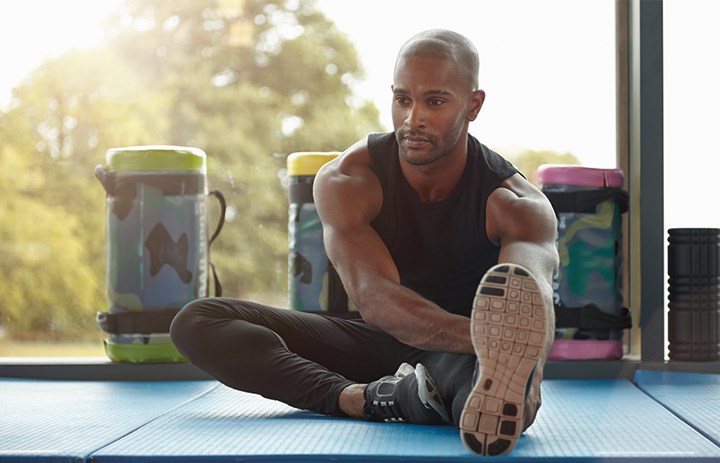
The tests you’re about to discover are true game changers.
Perfect them and you’ll reduce your risk of injury while correcting the contortion that we humans inflict on ourselves by sitting and slumping all day long.
Run through the tests then weave the fixes into your routine. You’ll walk away with less pain, greater flexibility and more muscle.
TEST 1
Ankle Mobility
“If your ankles can’t flex when you squat or lunge, you’re going to compensate by leaning forward,” says physical therapist Mike Reinold.
ASSESS YOURSELF
Assume a lunge position with both knees bent 90° and the big toe of your forward foot 12 centimetres from a wall.
Try to touch your front knee to the wall. (Your knee should move over the outside of your foot, above your fourth toe.)
Switch legs and repeat the test with the other knee.
You pass if you can touch both knees to the wall without raising your front heel off the floor.
FIX IT
Do a modified version of the test at least once a day: assume a lunge position, right foot forward, knees bent 90°.
Hold a dowel or massage stick vertically in front of the third toe of your right foot. Without lifting your right heel, drive your knee to the right of the stick as far as you can. Return to the starting position.
Do 10 reps, switch legs, and repeat, driving your left knee to the left of the stick.
TEST 2
Pelvic Tilt
Excessive sitting shortens your hip flexors, pulling your hips forward. That hyperextends your back and weakens your core. “Tight hips are the main cause of back pain,” says Reinold.
ASSESS YOURSELF
Lie on your back on a picnic table with your bum at its edge. Bring your knees to your chest, hugging them with your arms.
Release and slowly lower one leg as far as you can. Return it to your chest and repeat with the other leg.
If you’re able to bring each thigh below parallel to the table without arching your back, you pass.
FIX IT
Assume a lunge position with your right leg forward and both knees bent 90°.
Place your hands on your right thigh and push down to activate your core. Then place your hands behind your hips. Flex your glutes as you push your hips forward and down, feeling the stretch in your left hip.
Hold for five seconds, then return to the starting position. That’s one rep; do five reps, then switch legs and repeat.
Click here for the genius new exercise that will send your bench press through the roof
Test 3
Hamstring Flexibility
“Tight hamstrings prevent you from pushing your bum backwards – the all-important ‘hip hinge’ movement that allows you to keep your back in a safe, neutral position during moves like the deadlift and kettlebell swing,” says Reinold.
If you can’t hinge with your hips, you’re going to bend at the waist, straining your spine.
ASSESS YOURSELF
Stand tall with your feet together and arms by your sides.
Slowly reach for your toes, keeping your arms straight as you lower your torso.
You pass if you can touch your toes without bending your knees or rounding your back.
FIX IT
Place a dowel or rod against your spine, holding each end so it touches your head, the middle of your back and your tailbone. Keep your feet shoulder-width apart.
With the dowel in contact with all three points, hinge forward, pushing your hips back as if you’re closing a door.
Pause for two seconds when you can’t go farther without rounding your back. Return to the starting position. Do 10 reps.
Click here for the diabolical dropset that will pump up your chest and shoulders
TEST 4
Shoulder Range of Motion
“We’re always focused on what’s in front of us – computers, smartphones, TVs –which leads to slumping,” says Reinold.
That causes the muscles around your shoulders and spine to tighten. “Then when you do overhead lifts and presses, you compensate to get your arms vertical,” he says.
ASSESS YOURSELF
Stand with your head, shoulders and lower back flat against a wall, heels 20cm away.
Keeping your arms straight, try to touch the wall above your head with your thumbs.
You pass if you don’t arch your back or bend your arms.
FIX IT
Grab a tennis ball and place it between your right shoulderblade and a wall.
Move around to massage the muscles below your armpit. When you find a tender spot, move your arm up and down two or three times. Continue for 30-60 seconds.
Repeat on your left shoulderblade. When you’re done, foam-roll both areas on the floor for another 30 seconds.
Don’t forget to download the Olympics on 7 app!
Get it for Android – rio.seven/googleplay
Get it for iOS – rio.seven/appstore

















